Tom's Hardware Verdict
The Acer Predator Triton 300 is a lightweight gaming laptop with solid gaming performance and Max-Q Dynamic Boost. But it’s swimming in bloatware and offers lesser productivity performance than some competitors.
Pros
- +
Lightweight for a gaming laptop
- +
Strong port selection
- +
Max-Q Dynamic Boost usually adds a few frames
Cons
- -
Way too much bloatware
- -
Mixed productivity performance
Why you can trust Tom's Hardware
Even here in the middle of 2020, the best gaming laptops have a reputation for being thick, beefy machines. But the Acer Predator Triton 300 ($1,175 to start, $1,599.99 as tested) is not only thin, it’s lightweight at 4.4 pounds. Our review unit came armed with an Intel Core i7-10750H and Nvidia GeForce RTX 2070 Super Max-Q, sharing power with Nvidia Max-Q Dynamic Boost.
It all makes for a nice machine for gaming, but what about productivity performance? And Acer has layered the bloatware on thick, so get ready to take time uninstalling the bulk of it.
Design of the Acer Predator Triton 300
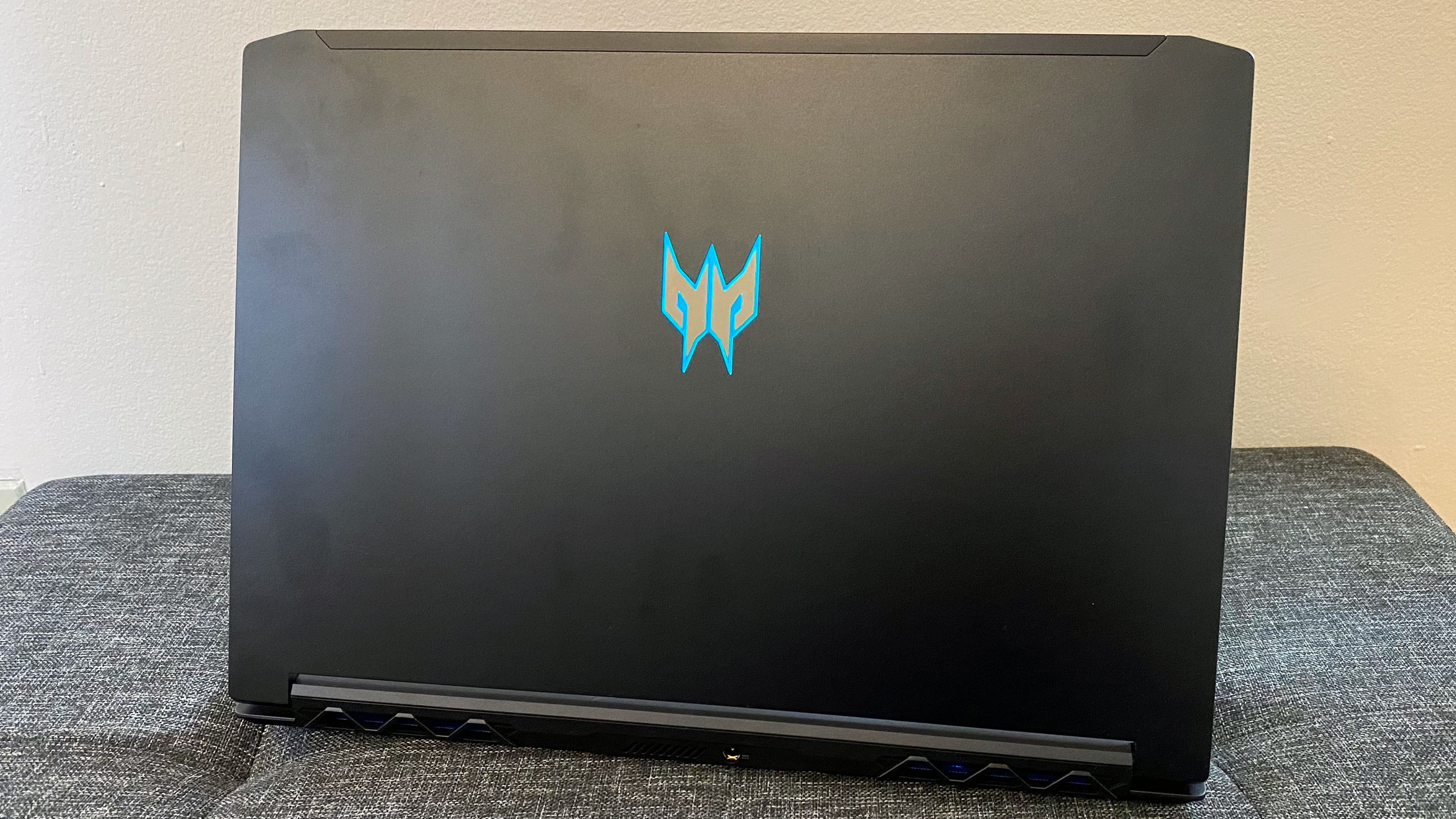
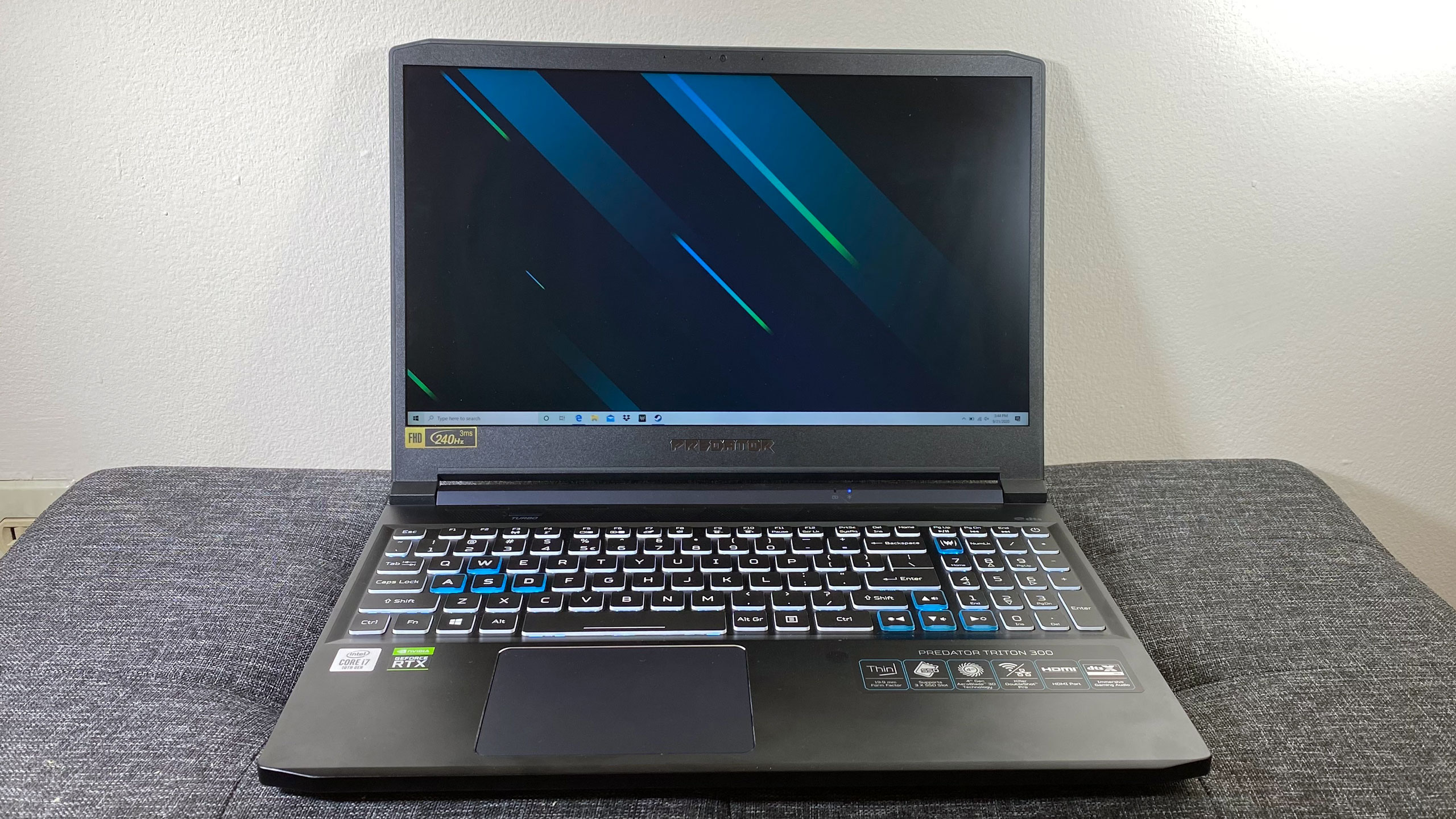
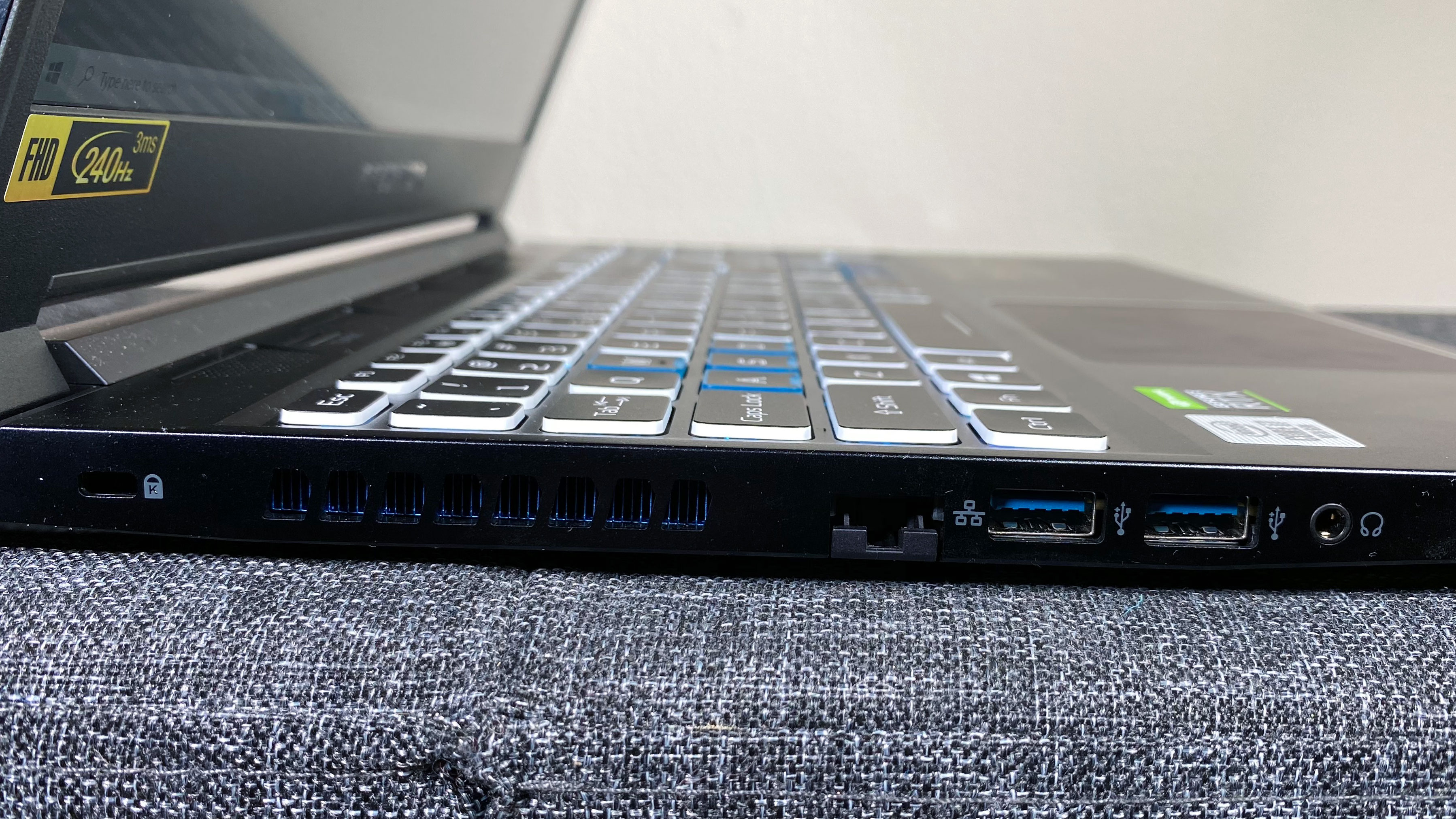
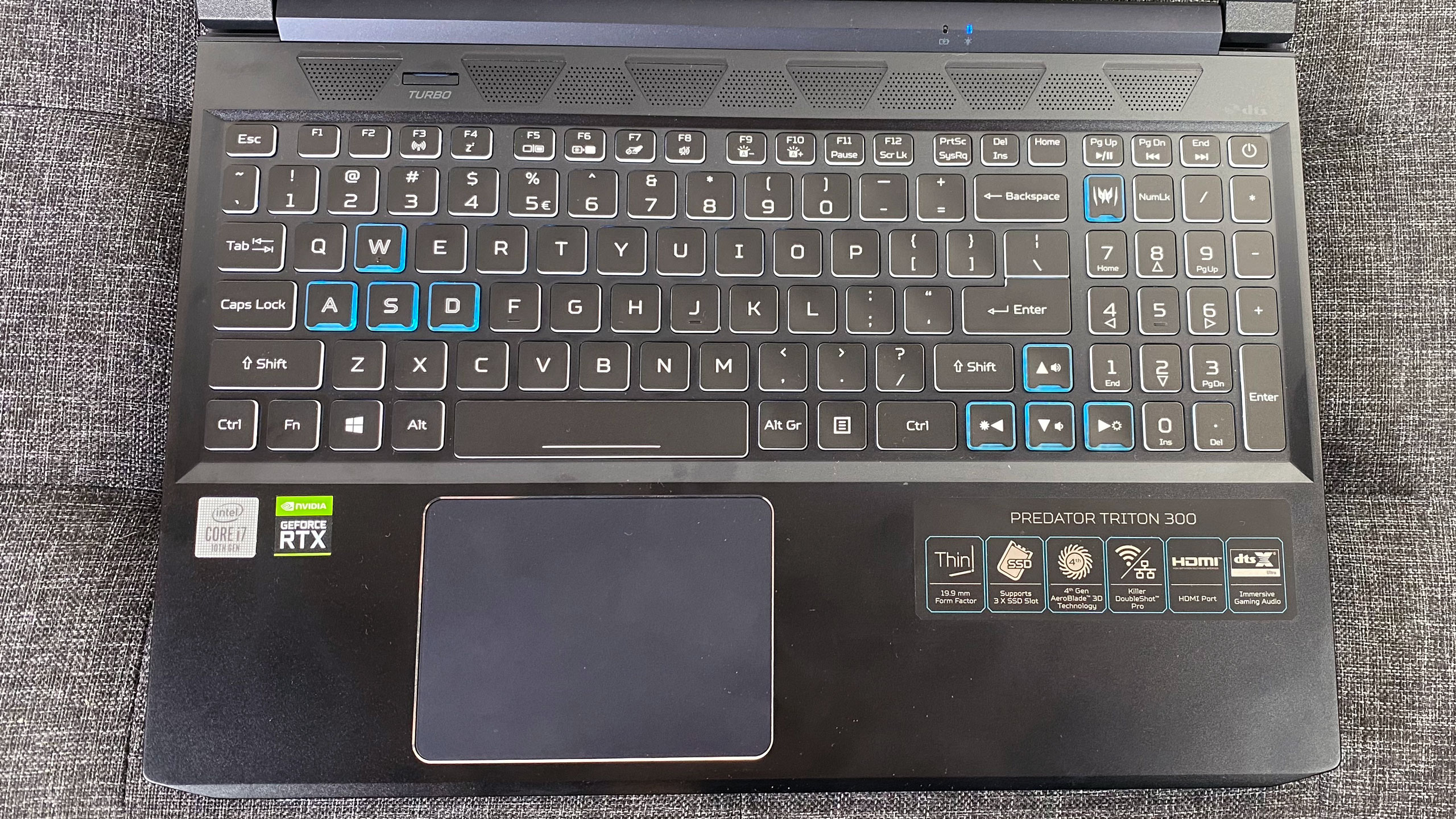
With the Predator Triton 300, Acer has refined its gaming laptop design in very slight ways. This is most notably the case on the lid. Sure, it still has the big Transformers-style logo on a dark gray/blue aluminum background with slight angles. But there is one very notable difference. Unlike previous laptops from this lineup we’ve reviewed, this one doesn’t have the word “Predator” printed in a large font on the back. I think this is a good idea, not only for clean design but because I’m not sure that’s a word I would want printed in a large font on my laptop.
When you lift the lid, you’ll find that the 15.6-inch, FHD display is surrounded by a moderately sized bezel with the Predator logo underneath.The keyboard is mostly white with blue accents around the WASD keys and the arrow keys, as well as the button to launch Acer’s PredatorSense software.
Most laptops keep the ports on the right and left sides, but Acer has put the power jack on the back (we’ve seen some other brands, like Alienware, put even more on the rear). This makes room on the side for more USB and other useful options. On the left side are two USB 3.2 Gen 2 Type-A ports, an Ethernet jack, a Kensington lock slot and a 3.5 mm headphone/mic combo jack. On the right lives USB 3.2 Gen 2 in both Type-C and Type-A varieties, as well as HDMI and mini DisplayPort.
At 4.4 pounds, the Triton 300 is lighter than its competition, though not necessarily smaller. It measures 14.3 x 10 x 0.8 inches. The Gigabyte Aorus 15G is 4.9 pounds but closest in size at 14 x 9.8 x 1 inches. The Alienware m15 R3 is 4.5 pounds and 15.2 x 10.9 x 0.8 inches, while the Lenovo Legion 5i is 4.8 pounds and 14.1 x 10.3 x 1 inches.
Specifications
| CPU | Intel Core i7-10750H |
|---|---|
| Graphics | Nvidia GeForce RTX 2070 Super Max-Q (8GB GDDR6) |
| RAM | 16GB DDR4-2933 |
| Storage | 512GB PCIe NVMe SSD |
| Display | 15.6 inches, 1920 x 1080, 240 Hz, 3ms |
| Networking | Killer Wireless-AX 1650i 802.11ax (2*2), Bluetooth 5.0 |
| Ports | USB 3.2 Gen 2 Type-C, USB 3.2 Gen 2 Type-A, 2x USB 3.2 Gen 1 Type-A, RJ-45 Ethernet, HDI, mini DisplayPort 3.5mm Headphone/microphone combination jack, Kensington lock slot, |
| Camera | 720p |
| Battery | 59WHr |
| Power Adapter | 230W |
| Operating System | Windows 10 Home |
| Dimensions(WxDxH) | 14.3 x 10 x 0.7 inches |
| Weight | 4.4 pounds (2 kg) |
| Price (as configured) | $1,599.99 |
Gaming and Graphics on the Acer Predator Triton 300
The Acer Predator Triton 300 is particularly interesting because it’s the first laptop we’ve tested with Nvidia’s Max-Q Dynamic Boost (more on that shortly) both on and off. The GPU, an RTX 2070 Max-Q, should let you play most games at high settings at 1080p. When I played Horizon: Zero Dawn at Favor Quality settings at 1080p, the game hovered around 70 fps as I hunted machines in Mother’s Embrace. It only dropped closer to 60 during direct melee combat with some Watchers that spotted me.
Dynamic Boost lets power switch, well, dynamically, between the CPU and GPU. It is on by default which, spoiler alert, is ultimately a good thing, as we largely (though not entirely) saw it giving us bumps in performance. If you want to turn it off, however, it’s located in Nvidia Settings. In most cases it’s not make or break.
Get Tom's Hardware's best news and in-depth reviews, straight to your inbox.
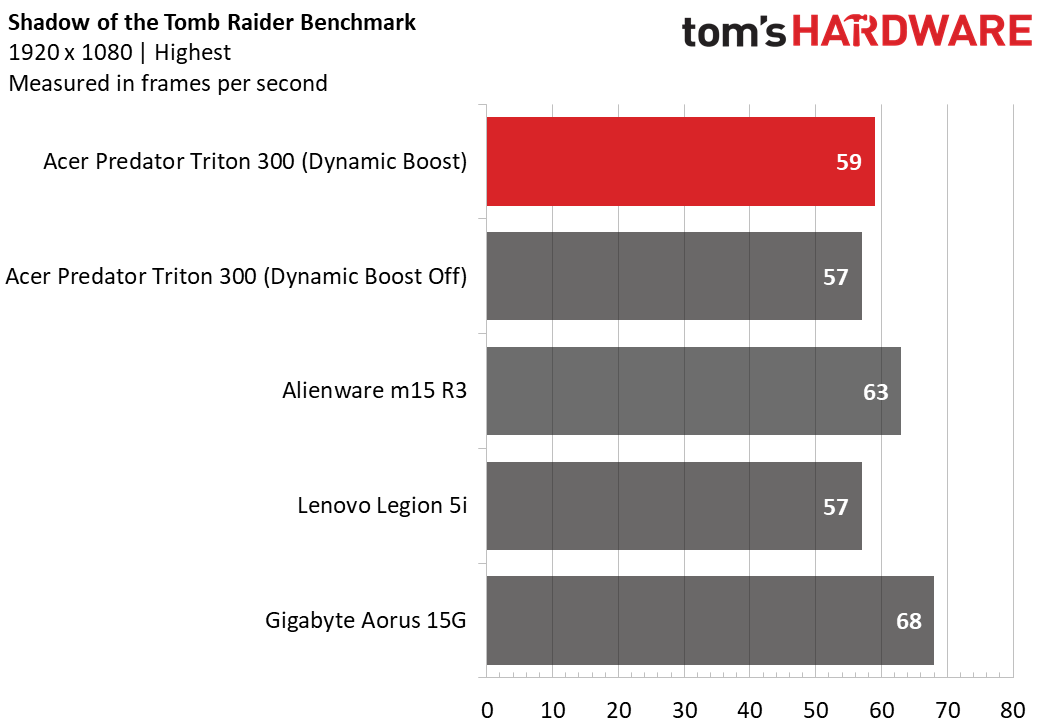
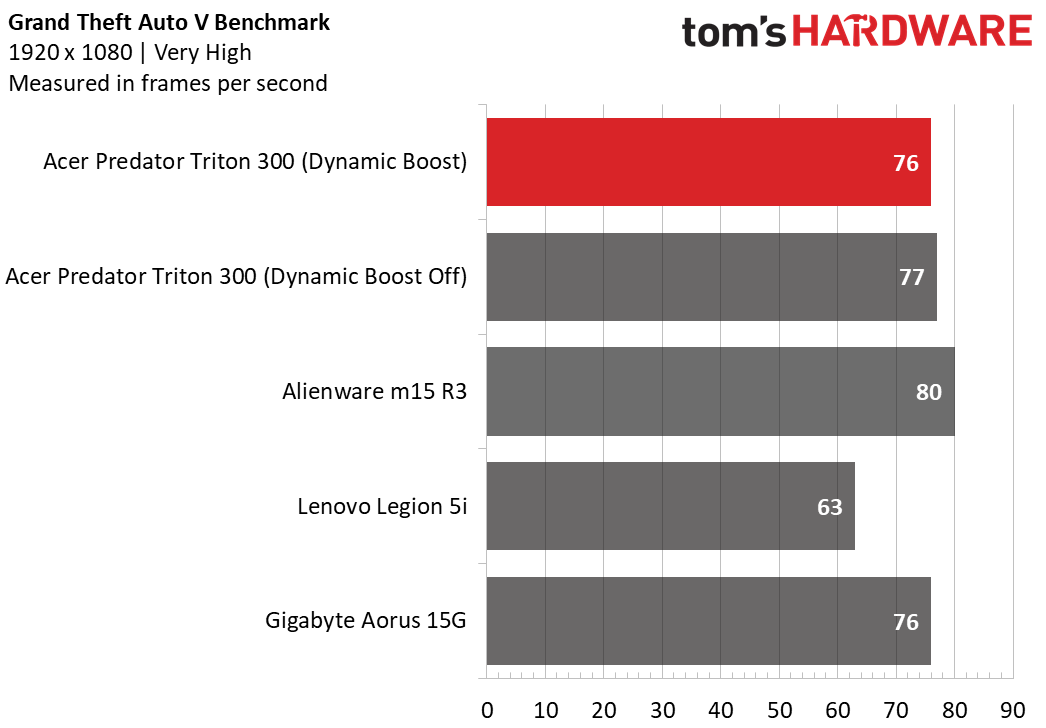

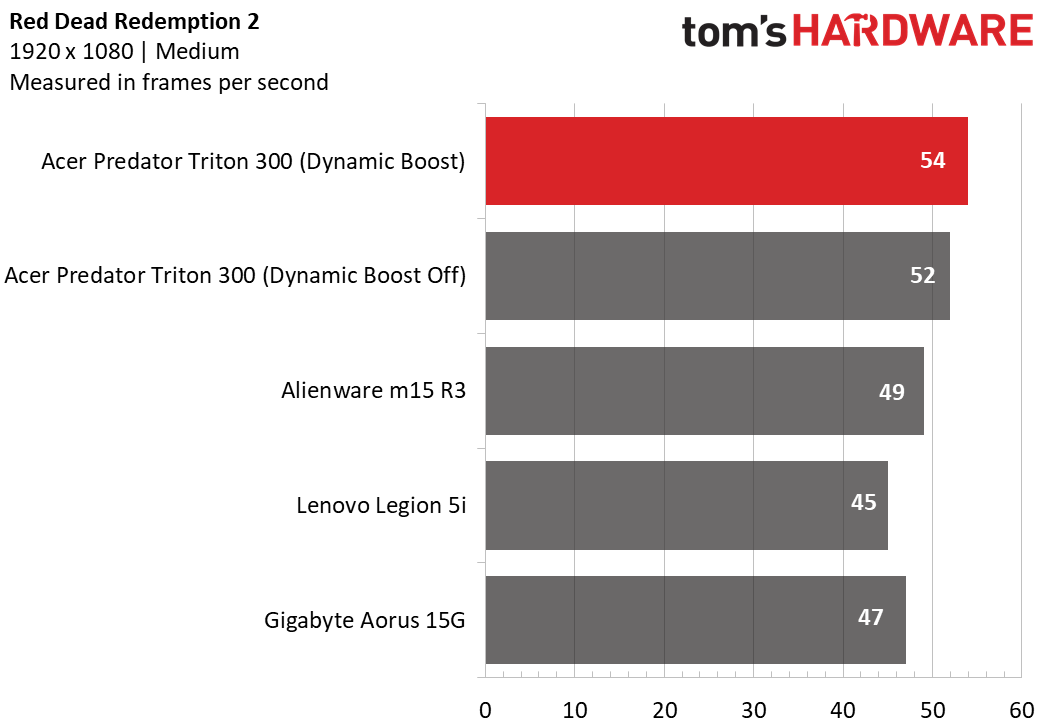
On Shadow of the Tomb Raider (1080p, highest), the Triton hit 57 fps with Dynamic Boost off, and 59 fps with it on. That’s similar to what we saw in the Lenovo Legion 5i (Nvidia GeForce RTX 2060), but the Alienware m15 (Nvidia GeForce RTX 2070 Super) and Aorus 15G (RTX 2070 Super Max-Q) both hit higher scores. That’s expected though, as those laptops use Super variants of the GPU.
The Triton gained an extra frame in Grand Theft Auto V (1080p, very high) with Dynamic Boost off, (77 vs 76 fps). That’s small enough to call it inconsequential. The Legion was lower, but unsurprisingly the Super cards offered more performance.
Dynamic Boost gave the Triton an extra three frames on Far Cry New Dawn (1080p, ultra) at 86 fps with it on and 83 fps with it off. That put it right up there with the more powerful GPU in the Aorus (87 fps), and was better than the Legion at 61 fps.
On Red Dead Redemption 2 (1080p, medium), the Triton ran at 54 fps with Dynamic Boost on and 51 fps with it off. Again, the greater number put it in league with the Gigabyte (54 fps), while the Alienware was still a bit ahead (59 fps).
We also stress tested the Triton 300 on Metro Exodus. We loop the test 15 times on RTX settings at 1080p to simulate roughly half an hour of gameplay.
With Dynamic Boost on, the Predator ran at an average of 48.2 fps. In this case, performance was slightly better without Dynamic Boost — it ran at an average of 49.4 fps with it off.
With Dynamic Boost on, the CPU ran at an average of 3.2 GHz at 83.8 degrees Celsius. The GPU ran at 1,197 MHz and 76.7 degrees Celsius with Dynamic Boost on, and 1,311.4 MHz and 77.6 degrees Celsius with it off. With Dynamic Boost disabled, the CPU ran at 3.7 GHz at 89.6 degrees Celsius.
Productivity Performance on the Acer Predator Triton 300
The Predator Triton 300 we tested came packing an Intel Core i7-10750H, 16GB of RAM and a 512GB SSD. Given that our entire test pool used the same CPU and amount of RAM, this laptop had slightly lesser performance in some areas, but was overall competitive.


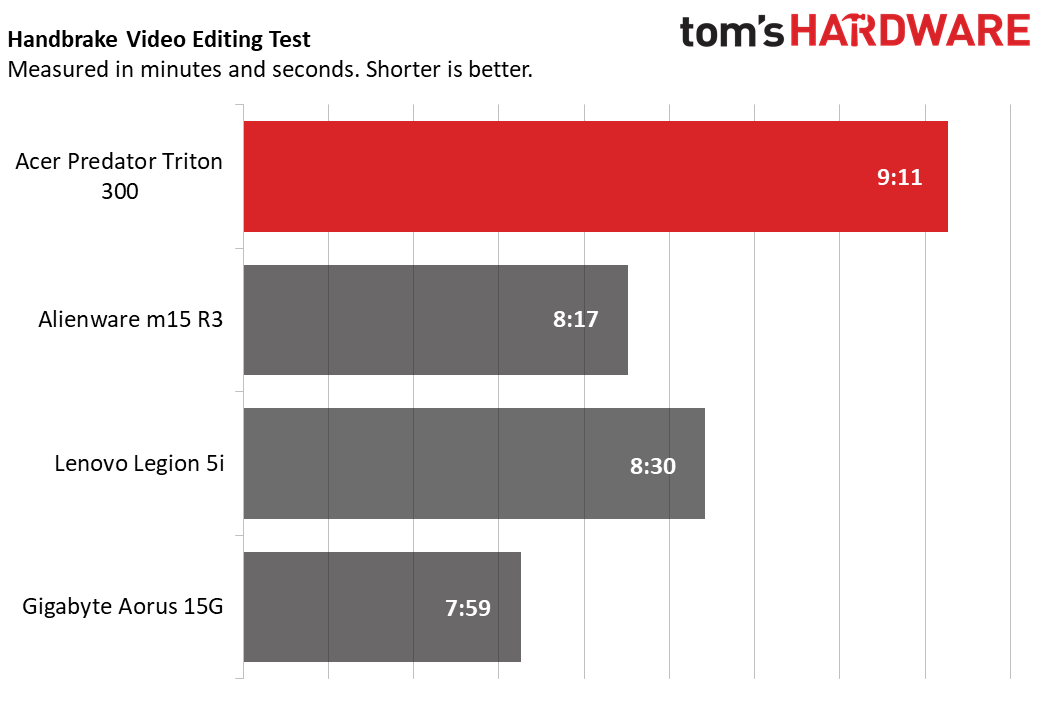
On Geekbench 5.0, an overall performance benchmark, the Triton earned a multi-core score of 6,194, just short of the Alienware m15 R3. The Legion 5i was slightly higher at 6,350, as was the Aorus 15G at 7,194.
The Triton copied 25GB of files at a rate of 955.8 MBps. That’s far faster than the Aorus (460 MBps) and the Alienware (713.7 MBps). Lenovo’s Legion was the closest at 926 MBps.
It took 9 minutes and 11 seconds to transcode a 4K video to 1080p in Handbrake. The rest of the field was faster, with the Aorus 15G leading (7:59).
Display on the Acer Predator Triton 300
We reviewed the Predator Triton 300 with a 1080, 240 Hz display. It’s not the brightest or most colorful we’ve seen, but it largely does the job.
On Horizon: Zero Dawn, the green pastures of Mother’s Embrace appeared lush and vivid, and I could see the blue sky for miles.
When I watched the trailer for Wonder Woman 1984, the panel excelled during bright scenes, like one with Wonder Woman flying above a military caravan and pushing two of them apart with her legs. It also looked nice in one scene where Stegve Trevor flies a jet through fireworks. A darker scene where the heroine faces off Cheetah wasn’t as vivid, but I could still make out the action.
The screen on the Predator covers 75.5% of the DCI-P3 color gamut, falling just behind the Alienware m15 (77.4%) and the Lenovo Legion 5i (79.3%). The worst of the bunch was the Aorus 15G, at 61%.
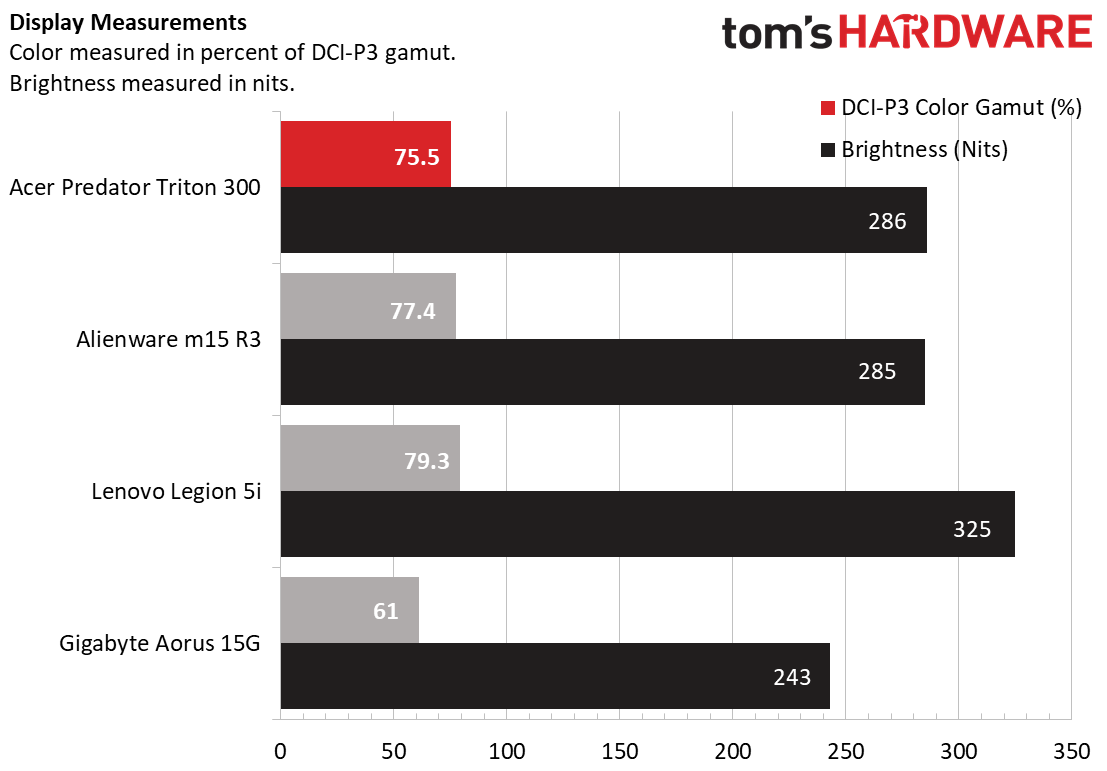
On our lightmeter, the Triton 300 measured an average of 286 nits of brightness, just one nit above the Alienware. The Aorus 15G was dimmer at 243 nits, while the Legion was the superior screen in this regard at 325 nits.
Keyboard and Touchpad on the Acer Predator Triton 300

Typing and gaming on the Triton’s keyboard is a mix. On the one hand, the keys are deep enough that you don’t bang your fingers on the aluminum frame. On the other, the keys feel cheap, and sometimes feel a bit wobbly if you don’t hit them in the exact center. Still, I managed to hit 110 words per minute on the 10fast fingers.com typing test, but with a slightly higher than usual error rate.
The 4.2 x 3.1-inch touchpad is polished and smooth. It’s got Windows precision drivers, and I never had any issues with three- or four-finger gestures. There’s definitely room for a bigger touchpad, though, which would be a nice improvement next time around.
Audio on the Acer Predator Triton 300
When I listened to Daft Punk’s “instant Crush,” the cymbals were what really struck me. Sure, the volume got loud enough to fill my apartment (that’s not hard) and the vocals were nice and clear and an electric guitar solo rang out. But there was a bit of punch there that I don’t always notice on laptops. It was also well-balanced with the duo’s famed synths.
The speakers were serviceable when I played Horizon: Zero Dawn, and I could hear crickets chirp as Aloy dove and ducked to avoid being seen while hunting machines.
You can pick between a handful of audio presets in the PredatorSense software, but I didn’t feel any of made enough of a difference to recommend bothering with them.
Upgradeability of the Acer Predator Triton 300

You need to take out a bunch of Phillips head screws to open up the Predator – 11 to be precise – and you’ll definitely need a pry tool to pop the bottom case off.
When you get in there, you’ll find that there’s plenty that you can fix, replace or upgrade. The battery, Wi-Fi card, SSD and both RAM slots are immediately accessible. Both of our RAM slots were filled, but you could replace the DIMMS and add more.
Additionally, there’s room for two more m.2 SSDs, should you want to add more storage beyond upgrading the boot SSD. That's a lot of room for a notebook at this price.
Battery Life on the Acer Predator Triton 300
Gaming laptops aren’t exactly hailed for long battery life, but the Triton does reasonably well, at least compared to competition. It lasted 5 hours and 51 minutes on our test, which continuously browses the web, runs OpenGL benchmarks and stress videos, all over Wi-Fi and at 150 nits of brightness.

You’ll still need to keep the charger handy. But the Alienware m15 R3 ran for 2:39 and the Legion 5i for just 3:13. Only the Aorus 15G went longer, at 6:16.
Heat on the Acer Predator Triton 300
We took surface temperature measurements on the Triton 300 while running our Metro Exodus stress test.
The center of the keyboard, between the G and H keys, measured 50.8 degrees Celsius (123.4 degrees Fahrenheit), making it a pretty hot place to keep your hands. The touchpad was cooler though, at 34.6 degrees Celsius (94.3 degrees Fahrenheit).

But the laptop got hottest on the bottom, at 62.9 degrees Celsius (145.2 degrees Fahrenheit). Don’t keep this on your lap while it's under load.

Webcam on the Acer Predator Triton 300
Like most laptops available right now, the Predator Triton 300 has a 1280 x 720p webcam. While that’s technically HD, it just doesn’t cut it anymore. A shot I took at my well-lit desk was a bit pixelated. It’s good enough to chat with some family, I guess, but nothing I’d be proud to show my face with.
At least colors were accurate. My sweater was the right shade of gray, and my beard was the right mix of red and brown, even if it looked like someone photoshopped it onto my face.
Software and Warranty on Acer Predator Triton 300
The go-to software on the Triton 300 is Acer’s PredatorSense app, which lets you check system temperatures, adjust lighting, overclock the GPU, adjust fan speeds, see system statistics and more.
But Acer also loaded this laptop up with bloat. It added Netflix, GoTrustID, PhotoDirector, PowerDirector and Acer Collection S, which links to more free apps like Hulu, Messenger, and Facebook that you could easily find on Microsoft’s own store. Of course, there’s also Norton Security Ultra.
That’s all on top of the bloat already built into Windows 10 in the first place, like PicsArt Photo Studio and Hidden City: Hidden Object Adventure.
The company also added referral links to Amazon and Booking.com to the Edge browser’s bookmarks bar.
Acer sells the Predator Triton 300 with a 1-year warranty. Previously, Acer sold all Predator laptops with a 2-year warranty, but that has now changed, which is disappointing as it made those models a better value.
Configurations for the Acer Predator Triton 300
We tested the Acer Predator Triton 300 in a $1,599.99 configuration with an Intel Core i7-10750H CPU, Nvidia GeForce RTX 2070 Super Max-Q, 16GB of RAM, a 240 Hz FHD display and 512GB of SSD storage.
For $1,175, there’s a version with the same CPU, RAM and storage, but an Nvidia GeForce RTX 2060 and a slower 144 Hz display.
Options go up to a $1,799.99 version with the same CPU and GPU, but 32GB of RAM and a 1TB SSD. Notably, this also has a slower 144 Hz than our review unit.
Bottom Line
The Acer Predator Triton 300 is a lightweight gaming rig with plenty of ports for expandability and, more importantly, solid gaming performance. Nvidia’s Max-Q Dynamic Boost has a tendency to add a few frames, which is a plus, but not s make-or-break difference. But Acer, even on its $1,000-plus laptops, continues to add copious amounts of bloatware, which puts a damper on the initial experience. The machine also had some slightly lower productivity performance scores than we expected, though its SSD still stood up to the competition.
The 240 Hz screen option is a boon for some esports players. Those who want more can check out the 300 Hz display on the Alienware m15 R3, though that is one you’ll want to keep plugged in all the time.
But if your focus is on gaming, you want solid build quality and don’t mind spending time uninstalling some junk, the Triton 300 is a solid gaming laptop option.
Andrew E. Freedman is a senior editor at Tom's Hardware focusing on laptops, desktops and gaming. He also keeps up with the latest news. A lover of all things gaming and tech, his previous work has shown up in Tom's Guide, Laptop Mag, Kotaku, PCMag and Complex, among others. Follow him on Threads @FreedmanAE and BlueSky @andrewfreedman.net. You can send him tips on Signal: andrewfreedman.01
